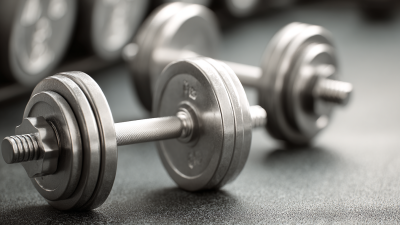In the ever-evolving world of fitness, the introduction of the rotating dumbbell has revolutionized how individuals approach strength training and full-body fitness. As fitness expert Dr. Jason Collins, a renowned trainer and author, emphasizes, "Incorporating rotating dumbbells into your workout routine not only enhances muscle engagement but also promotes better joint stability and flexibility." This innovative tool allows users to maximize their training efficiency, targeting various muscle groups while minimizing the risk of injury.
Understanding how to use rotating dumbbells effectively is crucial for anyone looking to unlock their full-body fitness potential. Unlike traditional dumbbells, these rotating variants create a unique dynamic that challenges the body in new ways, making workouts both engaging and effective. By mastering the techniques and proper form associated with rotating dumbbell exercises, individuals can amplify their strength gains, improve their endurance, and achieve well-rounded fitness results.
This ultimate guide will delve into the top five exercises to perform with rotating dumbbells, shedding light on the proper execution techniques, tips for beginners, and insights into the benefits each exercise offers. Embrace the power of the rotating dumbbell and discover how to elevate your fitness journey to new heights.

Rotating dumbbells represent a significant advancement in strength training, enabling users to engage muscles more effectively through a multidimensional range of motion. According to research from the American Council on Exercise (ACE), utilizing rotating dumbbells can increase muscle activation by up to 35% compared to traditional static weights. This is primarily due to the unique mechanics that allow for a more natural movement pattern, which not only enhances strength gains but also improves joint stability and mobility.
When performing exercises with rotating dumbbells, it is crucial to understand the mechanics involved. The ability to rotate the weight means that during movements like presses or curls, the wrists and elbows can follow a more ergonomic path, reducing stress on these joints. A study published in the Journal of Strength and Conditioning Research highlights that lifters who incorporated joint-friendly equipment showed a 20% decrease in injury rates over a year compared to those who trained with standard weights. By integrating rotating dumbbells into your routine, you can unlock full-body fitness while minimizing the risk of injury, ensuring a more sustainable approach to your workout regimen.
Incorporating rotating dumbbells into full-body fitness routines offers numerous benefits that can enhance strength, flexibility, and overall workout efficiency. A study published in the Journal of Sports Medicine highlights that utilizing rotating dumbbells can engage more muscle groups simultaneously compared to traditional fixed weights. This engagement is attributed to the dynamic movements facilitated by the rotation, which activate stabilizing muscles and improve functional strength. This is especially beneficial for athletes and fitness enthusiasts looking to refine their movement patterns and build a well-rounded physique.
Moreover, research conducted by the American Council on Exercise (ACE) indicates that full-body workouts utilizing rotating dumbbells can increase caloric burn by up to 15% compared to standard resistance training. The versatility of rotating dumbbells allows for a wide range of exercises, including squats, lunges, and presses, which not only challenge the major muscle groups but also promote core stability. Additionally, integrating these tools into a routine may aid in injury prevention by improving joint stability and enhancing overall coordination, making them a valuable addition to any fitness regimen focused on holistic health and performance.
| Exercise | Muscle Groups Targeted | Benefits | Recommended Sets | Recommended Reps |
|---|---|---|---|---|
| Rotating Dumbbell Press | Chest, Shoulders, Triceps | Improves pressing strength and shoulder stability | 3 | 8-12 |
| Rotating Dumbbell Row | Back, Biceps | Enhances back thickness and grip strength | 3 | 8-12 |
| Dumbbell Squat to Press | Legs, Shoulders | Full-body engagement, improves coordination | 3 | 10-15 |
| Rotating Dumbbell Deadlift | Hamstrings, Glutes, Lower Back | Increases posterior chain strength and flexibility | 3 | 8-12 |
| Rotating Plank Row | Core, Back | Strengthens core stability and back muscles | 3 | 8-10 |
Rotating dumbbells are becoming increasingly popular in fitness routines, and for good reason. They offer unique advantages that can enhance full-body workouts. According to a study published in the Journal of Strength and Conditioning Research, incorporating rotational movements can significantly improve muscle activation and strength gains compared to traditional weights. This is particularly effective for engaging core muscles while simultaneously working the arms and legs.
To maximize results with rotating dumbbells, athletes should focus on essential exercises like the rotational press, wood chop, and Russian twist. The National Academy of Sports Medicine highlights that these movements not only target multiple muscle groups but also improve overall balance and stability. By integrating just a few sets of these exercises into a weekly routine, participants can expect to see improvements in not only strength but overall functional fitness.
A report from the American Council on Exercise states that incorporating rotating dumbbells can boost workout intensity by up to 20%, making them a powerful tool for anyone looking to elevate their fitness game.
When using rotating dumbbells, safety should always be a priority to prevent injuries and maximize effectiveness. Before engaging in any workout, including those utilizing rotating dumbbells, proper setup and form are crucial. Just as improper posture in cycling can lead to poor performance and injury, incorrect form during dumbbell exercises can diminish your results and increase the risk of strain. Focus on maintaining a controlled movement and stable posture, ensuring that your core is engaged to provide the necessary support for your spine.
Another common mistake is neglecting essential warm-up routines or attempting to lift weights that are too heavy without mastering the basic techniques. Just as fitness classes often highlight the importance of bike setup to enhance performance, understanding the right weight and ensuring proper execution with rotating dumbbells are equally vital for safe training. Incorporating exercises like the dumbbell row with precise form can strengthen your back while reducing the likelihood of injury. Remember, it's not just about intensity; it's about executing each movement correctly to reap the full benefits of your workouts.
When it comes to full-body fitness, incorporating
rotating dumbbells into your workout can create a balanced regimen suitable for all fitness levels.
According to a report from the American Council on Exercise (ACE), using free weights like dumbbells can significantly enhance
muscle activation compared to machines, leading to more effective strength gains.
Rotating dumbbells are designed to engage multiple muscle groups simultaneously, promoting coordination and stability
while also improving functional strength.
To foster a balanced workout plan, start by integrating exercises that target all major muscle groups,
such as squats, presses, and rows.
For beginners, aim for lighter weights with higher repetitions to master form. More experienced individuals
can incorporate heavier weights with lower reps to build strength. ACE suggests combining strength training
with cardio to maximize overall fitness; therefore, incorporating high-intensity interval training (HIIT)
with rotating dumbbells can elevate your heart rate while building muscle.
Tips:






